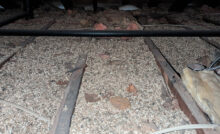Rockwool Insulation
Stone Wool Insulation Commonly Known as Rock Wool


Excellent Fire Resistant Properties
As you can see in the photo rock wool type insulation have excellent fire resistant properties. Roxul brand insulation (shown) has a melting point of 2,150°F. Obviously this gives it a huge advantage over insulation products like foam, fiberglass and cellulose which are all flammable at much lower temperatures.
The fire resistant properties are so good that this type of product is often used for fire blocking applications, insulating around chimneys and fireplaces and situations where the insulation needs to be left exposed. Obviously these type of special applications must be approved by the location building code official and meet the requirements of your local building code.
Excellent Water & Moisture Resistant Properties


Dimensionally Stable
One of the characteristics of this insulation that I really like is how dimensionally stable it is. Rock wool insulation products maintain their shape really well. Unlike fiberglass insulation that is easily compressed and unlike cellulose that settles over time rock wood insulation will hold it’s shape. This is extremely important in situations where a snug fit is all that keeps the insulation in place.
My Favorite Use
Over the years I’ve used rock wool insulation on almost every building project. It’s not a product that we’ve used in large quantities but it is a product that can be extremely useful. One of the most common applications that I use it for is insulating around fire place inserts. Today more and more people are installing gas fireplace inserts in new home designs.
The bummer about inserts is all the clearances you need to combustible materials. If you maintain those clearances with products like fiberglass and cellulose then you end up have a large area of you home without any wall insulation. Obviously that’s something we want to avoid especially with the cost of fuel these days.
So we use rock wool insulation to insulate the area of the clearance zone. This allows us to maintain the fireplace clearances while maintaining the building’s insulation barrier.
Recent Posts
Framing Stick Nailer vs Coil Nailer
Which is Better a Stick Nailer or Coil Nailer? Framers have many choices in nailers…
How Many Roofing Nails Per Square of Shingles
Estimating How Many Nails for a New Roof When it comes to estimating materials for…
Composite / PVC Decking – Layout Tips & Advice
Composite / PVC Decking Layout Tips and Advice Composite and PVC decking have really changed…
Benefits of an ERV System (Energy Recovery Ventilator)
Benefits of ERV Systems (Energy Recovery Ventilator) If you're building a new home or doing…
Vermiculite Attic Insulation Abatement
Vermiculite Attic Insulation If your home was built before 1990 there is a chance it…
Nuisance Tripping of AFCI (Arc Fault) Circuit Breakers
Arc Fault (AFCI) Circuit Breakers Tripping Often An arc-fault circuit interrupter (AFCI) or arc-fault detection…

View Comments
What is the cost compared to other insulation? And, is it hard to find an installer?
The cost varies depending on the size you want. Cost can be similar to fiberglass up to 20% more. Most all insulation contractors have access to it.
Have a link or additional info for rockwool around fireplaces? I'm at that point in my install currently and would love to see some more info so I don't burn my place down in the future.
Check this out Jeff:
http://www.roxul.com/files/RX-NA-EN/pdf/SafenSound-9-22-09.pdf
The key here is to insulate the wall in this area like you normally would. You really don't want to keep this stuff up tight against the firebox unless you have to. I'd read the spec closely.
Is this what they also use for sound barrier between floors (basement and main floor).
It is used quite often in that application.
It is the best and easist insulation to use for a DIYer! Use an electric carving knife, works great!
It costs more than fiberglass but is way easier to install. Unbeliveable sound deadining!
Great Stuff foamed all framing (100 cans - $ 600) and then used Roxul R-23 brand rock wool!
Inspector said "best insulation job I have ever seen" , " this is the first residential application I have ever seen" , Rock wool is not the norm around here (Tahoe), I had to special order from Lowes. I still used kraft faced R-38 fiberglass in the cathedral ceiling.